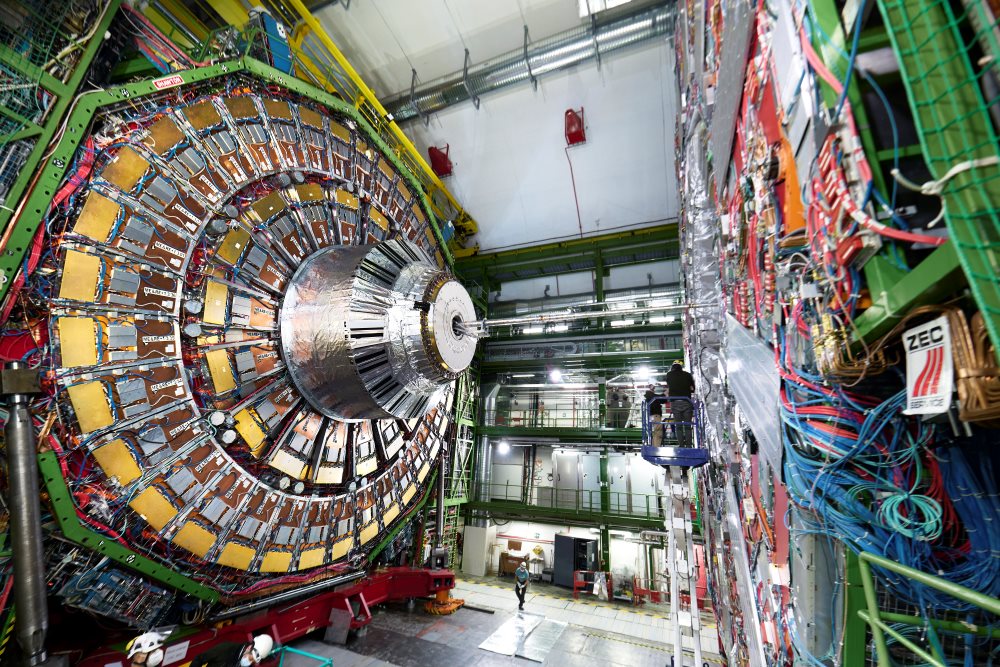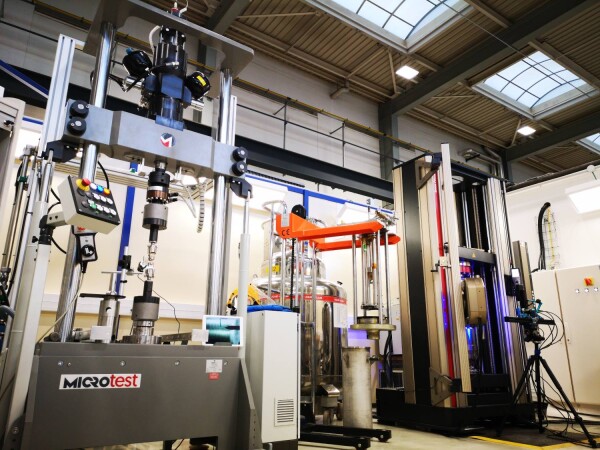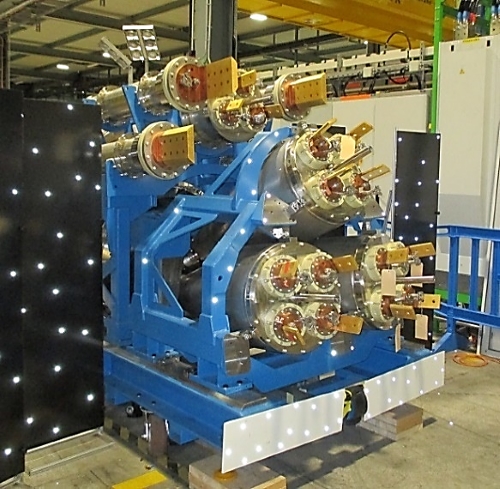- 7 March 2024
- Reading time: 8 minute(s)
CERN: requirements for material purity require insight into the entire production process

Engineers at CERN place high demands on the material cleanliness and purity for the vacuum systems of the particle accelerators and the experiments. This starts with the metallurgical process, where extreme cleanliness is required to prevent any leakages in the final components of the vacuum or cryogenic systems. "You have to understand and control the entire production chain," says Stefano Sgobba, Head of CERN Materials, Metrology and NDT.
Stefano Sgobba will give a keynote lecture on the challenges CERN is facing in the field of materials for vacuum and cryogenic applications in the particle accelerator on 16 April during the Clean Event of Mikrocentrum. Using concrete examples, he shows the importance of mastering and understanding the entire material production chain, from melting to final heat treatments, brazing, welding, etc. In his keynote lecture, he will also elaborate on the thermal shields of the vacuum vessel for the ITER project, with which CERN is working closely.
Absolute reliabilit
The decades of experience that CERN (European Organization for Particle Physics) has with cleanliness is linked to the quality of the materials for vacuum applications, Stefano Sgobba explains. If these materials do not meet the strict requirements, leak-tightness under ultra-high vacuum and/or cryogenic conditions is not guaranteed. One of the challenges is the wide temperature range in which the properties of the materials must be stable: from above room temperature down to almost absolute zero. "Usually our physicists have high requirements about the ideal materials they want and we translate them into engineering specifications that may be extremely challenging but industrially feasible," says Stefano Sgobba when explaining the way of working at CERN

CERN facilities for mechanical testing of materials down to cryogenic temperature (4.2 K), including fracture mechanics testing. (Foto: CERN)
For the most demanding applications, it is rare to be able to use out of the shelf materials that are in stock in the trade. Impurities and non-metallic inclusions can have an undesirable effect in the end application. CERN therefore wants insight into the entire process, from metallurgy to processing and possible thermal post-treatment. Stefano Sgobba: "We usually look at the entire production cycle of material, by enforcing in the specifications the right metallurgical processes already at the level of the casting and remelting. We agree on a so-called manufacturing and inspection plan with the producers; we attend the most critical steps in production and do intermediate and final receiving inspections in order to ensure that the materials are reliable.
Usually our physicists have high requirements about the ideal materials they want and we translate them into engineering specifications that may be extremely challenging but industrially feasible” Stefano Sgobba
A leak in the innermost part of a detector or a superconducting magnet is absolutely unacceptable." According to him, this comprehensive and consistent approach is one the bases of the result that CERN achieves. That's not only because of non-destructive testing at the end, that may not be able to detect all possible detrimental features in the parts. "If someone is undergoing surgery and you know you can't intervene twice, you have to have absolute reliability. It's the key to success." A handicap in this approach is that CERN is not as big a customer as, for example, the automotive industry. "Nonetheless, it has to remain cost-effective," Stefano Sgobba notes. "And over-specifying should be avoided.
Manufacturability
The purity of the materials is paramount at CERN. At the same time, one must keep an eye on machinability, for example how the material is machined or how well it can be welded. Sometimes a compromise has to be sought, because the parts have to be manufacturable. CERN's Head of Materials, Metrology and NDT gives the example of the use of high-purity copper in a particular application. Pure and soft copper is actually needed for the highest electrical and thermal conductivity in cryogenic conditions. So you would choose a fully annealed copper.
On an industrial scale, it's always important to ask yourself what you really need”
Stefano Sgobba
"However, in order to improve machinability, we opt for a harder copper temper." To make austenitic stainless steel easy to machine (the so called ‘free machining grades’), producers usually add Sulphur. Normally, that's not a problem in standard grades; for CERN, that uses fully austenitic grades to limit magnetic permeability in several applications, this increases the risk. Therefore, CERN limits the presence of Sulphur in the material.

3D laser-based optical metrology inspection of complex components at the Materials, Metrology and Non-Destructive Testing of CERN. (Foto: CERN)
Another example: the concentration of Cobalt in the stainless steel composition must not exceed 0.10%. In the past, the limit was 0.20%, but in order to reduce the activation of components close to the beam following operation, the limit value is now 0.10%. This upper limit for Cobalt is hardly met by out of the shelf products, hence it generally requires dedicated productions. Traces of delta ferrite are often permitted or even wished in general industrial applications, but are undesirable for specific applications at CERN because they increase magnetic permeability above the maximum allowed limits and reduces toughness at cryogenic temperatures. That's why CERN is trying to limit them. Manufacturability certainly plays a role in the selection of materials, Stefano Sgobba summarises. "On an industrial scale, it's always important to ask yourself what you really need."
Cleanliness
CERN holds records for vacuum applications, in terms of achieved vacuum levels but also in terms of the very large vacuum systems. Surface cleanliness also plays a role in this. Moreover, preparation of parts for high vacuum brazing, which is also a technology in which CERN is a reference, requires a very controlled cleanliness of the parts to be assembled. Quality requirements of parts submitted to high vacuum brazing are very similar to the ones applicable to the semi-conductor industry. At CERN, the visual aspect and visual inspection of the surface also play a role.

CERN facilities for mechanical testing of materials down to cryogenic temperature (4.2 K), including fracture mechanics testing. (Foto: CERN)
For example, products and welds must be absolutely clean in terms of the absence of residues of scale, tint oxides, etc.. Any form of root porosity in welds is out of the question. The use of certain fluids is also prohibited because they contain chemical components that lead to problems afterwards to achieve the final vacuum requirements. Surface imperfections, such as open porosities or folds, may have a negative effect on the cleanability of the components, may retain chemicals and be the cause of virtual leaks. In terms of cleaning, it is sufficient to apply a chemical cleaning for some parts; For others, they undergo a vacuum firing at temperatures up to 900 degrees to outgas the material. "In that case, the last step is not the chemical cleaning, but this is followed by the treatment under vacuum, which has a purifying effect."
Additieve productie
Stefano Sgobba expects the requirements for structural components as applied for example in compact fusion energy devices or new accelerators at CERN to become stricter in the future. This does not necessarily mean that new grades need to be developed, as it has been the case in the past for the beam screen of the LHC. Rather, it will be focused on optimization of combination of properties and their homogeneity across the parts, for specific applications or techniques.
[nicequote payoff="Stefano Sgobba"]Our challenge is to achieve similar physical properties as with bulk materials, not necessarily a new material, but an improved process for the ultimate goal/nicequote]
For example, he points to a very large forgings whose fracture toughness and strength you have to guarantee at cryogenic temperatures. It may be achieved for standard forms of products, but not for parts of very large size or complex shape. A second example is additive manufacturing at CERN, in particular laser powder bed metal printing. "Our challenge is to achieve similar physical properties as with bulk materials, not necessarily a new material, but an improved process for the ultimate goal."
Keynote lecture during Clean Event
The keynote lecture by Stefano Sgobba on the metallurgical aspects that are important to make a material suitable for vacuum and cryogenic applications will take place on 16 April during the Clean Event. Mikrocentrum organizes this simultaneously with the Manufacturing Technology Conference in the NH Koningshof conference center in Veldhoven. Your visit is for fee, register yourself on this website.
Register your free visit for Clean Event
How can the entire supply chain collectively achieve control over cleanliness and contamination throughout the manufacturing process? How can you ensure a smart design that facilitates both the initial cleaning of the product and its sustained cleanliness in subsequent stages? These challenges will be the focal point of the Clean Event on April 16, 2024.
More information and free registrationNews
Lees ook deze blogs
- The tool shop of the motion plastics specialist igus uses innovative cooling lubrication concept in automated production cell
- 5 trends for the plastics industry
- Without logistics, everything stands still
- Broad knowledge of manufacturing techniques ensures future-proof industry
- AI in the manufacturing industry: avoid a Sherlock Holmes syndrome
